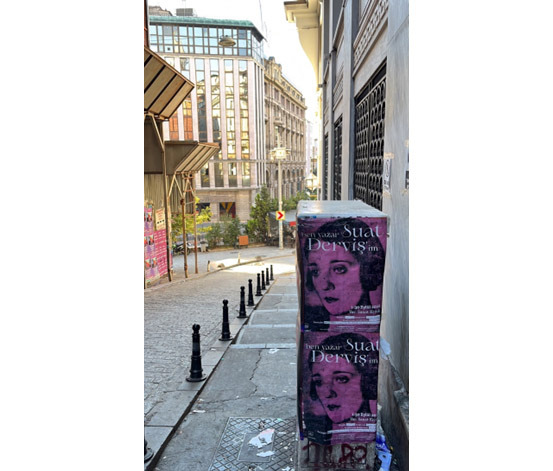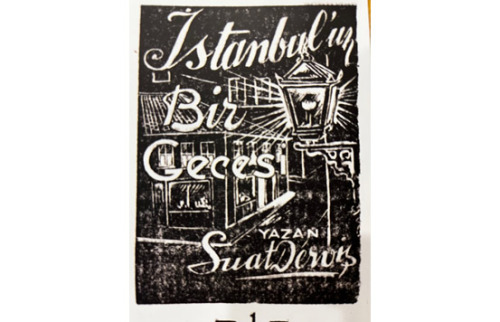
On 24 September 2022, I was to reside in İstanbul once again, after almost six years. I was very excited to live in Beyoğlu. I promised myself to take a morning walk regularly, before İstiklal Street becomes busy with pedestrian traffic. I could walk to Gezi Park and back to Tünel and perhaps have my morning coffee in a different small coffeeshop each time. At my own pace, paying attention to the carvings on the old buildings, taking small breaks to look at the sky, those morning walks could be the time for me catch up with İstanbul and myself.
One morning I am walking down Yüksek Kaldırım Street to go to Karaköy. I am about to merge with Bankalar Street. There, I saw on my right two identical purple banners. They announce that the “I am the author Suat Derviş” exhibition will remain open until 30 September 2022 in the Avrupa Arcade in Beyoğlu. Born into a wealthy family in late Ottoman İstanbul, Suat Derviş (1903–1972) was a journalist, novelist, feminist, and communist. Fatmagül Berktay describes Derviş as a critical and perseverant outsider both to “ruling bourgeoisie” and “formulaic left” circles of her time, “a rebel refusing to be a victim.” The more I look at these identical banners, the more Derviş becomes alive. It feels like she is slightly bending her head. I have six days to see the exhibition. I should not forget it.
The same but larger Suat Derviş banner welcomes us in the Avrupa Arcade. With a dear friend, we find the modest exhibition hall on the second floor. My friend is surprised that Derviş had done so much politically in her life, yet so little is known about her. I couldn’t agree more. I purchase Derviş’s interviews, entitled Çöken İstanbul (Collapsing İstanbul), and one of her many novels, Fosforlu Cevriye. I enjoy and finish reading them in a week. Given her attention to poverty in İstanbul in the 1930s, some of her interviews remind me of Friedrich Engels’s The Condition of the Working Class in England (1845). Perhaps it is the power of ethnography that I find common in both, almost a century apart. Pınar Öğünç describes Suat Derviş as “a recording device with a heart and a brain.”[1] I agree. Derviş conveys the hardships, feelings, or persona of her everyday interviewees in a non-condescending way, creating a sense that the reader strolls in İstanbul’s backstreets with her. Derviş’s work doesn’t feel old, because similar class realities and experiences prevail today.

Fig. 2. Avrupa Pasajı, 27 September 2022 (by author).
Let me give some examples from “What Could Be Seen on Beyoğlu Street in a Cold Winter Night?”—an account of her trips to İstiklal between 6 February 1937 and 6 March 1937. Walking on the street with her husband, Derviş is surprised when a woman violet seller appears from nowhere and approaches them to sell some flowers. They don’t buy any.[2] In 2023’s Taksim, there are young school age boys who approach couples on the street to sell red roses day and night. They extend the rose without saying much. It seems that they have mastered all of İstiklal’s backstreets and are very alert to municipal police. If you ask an address from these young boys, their directions would more or less like this: “Take the first left and take the fifth right.” They learn to count the streets as they learn to take cash and give change—the calculus of the streets.
In February–March 1937, Suat Derviş encounters several Nazis in a restaurant cooking German dishes in Beyoğlu. With the military uniforms they wear in public and greeting each other by praising Hitler, Derviş gets angry at them since they act as if “they live in a colony.” A gramophone in the restaurant plays their national anthem, and soon after, Derviş leaves the restaurant.[3] After this uncomfortable lunch, Derviş wants to have a cup of coffee in one of the “hundreds of Viennese cafes in Beyoğlu.” She sees newspapers in German, Hungarian, Polish, and Czech and overhears conversations about politics or people reading the news while sipping their coffees.[4] She can’t really tell why these people ended up in İstanbul and whether they are political refugees or migrants.[5] A night in Beyoğlu ends when she sees a drunk woman singing a popular song in Germany in the mid-1930s, “Im Berlin an der Ecke von der Kaiserallee.”[6] I cannot help but think whether a version of the “Occupied City” exhibition by the İstanbul Research Institute could be done for İstanbul in the 1930s.
Deep into the night in a restaurant-club with live music, Suat Derviş hears different people competing to make the band to play Yanık Ömer, a song narrating the sorrows and joys of a male peasant returning from the First World War, or Harmandalı, a track to perform the zeybek folkdance. I am not sure if I heard these on İstiklal, but I was surely exposed to 1990s Turkish pop, either played live or on playback a lot. Perhaps entertainment patterns have changed over the decades, but the order of songs in the playlists remains almost the same every night. Everything reminds me that it is work for someone and commodified leisure for others. Of course, I also listened to the children trying to play Bella Ciao on their melodica for hours to collect a bit of cash. They only played the first five notes right. It could not really go further in the duration of the nine months that I have had in Beyoğlu. The streets are fast-paced and not very suitable to learn some things. Engaging with Derviş’s work on workplace injuries of women in the 1930s, Aslı Odman describes the bodies at work as “accelerating bodies.” İstiklal, as a sphere of circulation and of entertainment, makes me think about speed and acceleration while I witness children playing their melodicas, as well as many other modes of existing, like the feminization of municipal sanitation work and of minimum wage jobs.

Fig. 3. Cover of Suat Derviş’s book İstanbul’un Bir Gecesi (by author).
Inspired and encouraged by Suat Derviş, I have become more attentive to my surroundings and life in Beyoğlu. I could not take morning walks as regularly as I wanted, partly because İstiklal in the mornings is full of white trucks of almost identical size racing each other to deliver commodities to their stores of destination. Packs of frozen potatoes to be deep fried leave the refrigerated trucks. These packs are smaller than the sacks of potatoes that one would normally think of or bigger than the packs that one could find in grocery stores. Yes, the size of these industrial packs must be adjusted according to the industrial fryers. I continue walking. In front of almost every famous retailer, I see trucks stacked with all kinds of attire in very thin and unvacuumed bags. Do those stores really sell that much, to replenish their stocks every week or twice a week? I can’t really tell. Maybe they do, considering consumerism, credit cards, and installments.
I decide to warn the driver of another truck one morning who drove too close to me and stopped in front of a candy store, killing the engine before coming to a full stop. I see three young males—the driver is older than the other two. Two in the passenger seats run to the back of the truck and unload the supplies. The driver half opens the door, holds it with his left elbow, stretches his right arm to reach to a list by the front window, takes the list and places it on his lap, crosses off something, and then immediately takes the cigarette from behind his ear and lights it. The list is probably of places to make deliveries to on the same day. They speak Arabic, so I want to communicate with them, but I am not confident with my colloquial skills, as I was trained more in fusha. I am terrified to sound formal and, even worse, not to make sense. In no time, I start thinking about the wars and displacement. Do these three men have proper health insurance? How much do they make? They are in a rush that they do not seem to enjoy or own; it must be an undesired pace of work. I am in Tünel.
I am heading to Karaköy again. “Tourism is the new plantation.” This sentence stuck in my mind after someone in the classroom said it in the Caribbean history course that I took very early in my doctoral studies. I think about tourism as a new cash crop. İstiklal’s early morning rush becomes more understandable: İstiklal as an open-air tourism factory or plantation. My mind loves analogies and aphorisms. They have fueled my working-class soul: İstiklal’s mornings as a late moment in the sphere of circulation, İstiklal’s afternoons as a shopping mall to realize value. Let’s not get charmed by the world of commodities, and don’t forget “the hidden abode of capital” in “the abode of felicity.” Yet, this time there is more. I overhear over days and weeks that many residential buildings in and around Karaköy have been purchased by investors to be repurposed as hotels. I notice it has already happened in the back streets of İstiklal. The cruise ships anchoring at the Galata Port seem to confirm all this. I wonder whether some horn blasts I tended to associate with the city ferries belonged to the cruise ships. Capital, labor, and rent—one must think about them all at once.

Fig. 4. Topkapı Palace from Cihangir (by author).
With the constant police radios that I hear every day on the İstiklal Street, perhaps louder when the street is closed to public gatherings, I think about Fosforlu Cevriye. To be able to meet with her dissident lover who tries to live a low-profile life, Cevriye runs away from the police or often tries to act without drawing much attention. Nergis Ertürk points out that Derviş does not just simply merge detective books and love novels in her writing. Rather she investigates “the possibilities and promises of left literature under the state of exception” and “demystifies the technique of writing” by weaponizing or instrumentalizing “the realist novel and realist representation.” As I walk through the streets of Beyoğlu, I am thinking about Suat Derviş, literature-history-politics, Derviş’s İstiklal, and now, how much capitalism has changed over the decades or has remained the same.
Anıl Aşkın
1 May 2023, Monday
İstiklal, Beyoğlu
————————————————————————————————————————————————-
[1] Pınar Öğünç, “Kalpli, Beyinli Bir Kayıt Cihazı,” in Çöken İstanbul Röportajlar (İstanbul: İthaki, 2021), 333–42.
[2] Suat Derviş, Çöken İstanbul Röportajlar (İstanbul: İthaki, 2021), 311.
[3] Suat Derviş, Çöken İstanbul Röportajlar, 319.
[4] Suat Derviş, Çöken İstanbul Röportajlar, 320.
[5] Suat Derviş, Çöken İstanbul Röportajlar, 321.
[6] Suat Derviş, Çöken İstanbul Röportajlar, 332.

